Find out the specific number of appliances that you can operate with your generator. Full wattage guide including power needs refrigerators, HVAC, kitchen appliances and more. Estimate your current power generator requirement.
Severe storms are always threatening and one never knows when their power will go out and you will be left guessing the appliances that can be put on your generator safely. Knowing the maximum loads of your generator and the power hunger of your appliances is essential in case of electric disasters so that you remain healthy and comfortable. This is a guide to all you need to know about connecting appliances to generators starting with simple calculations to which appliances to put where and how much power in each room.
Understanding Generator Wattage and Power Requirements
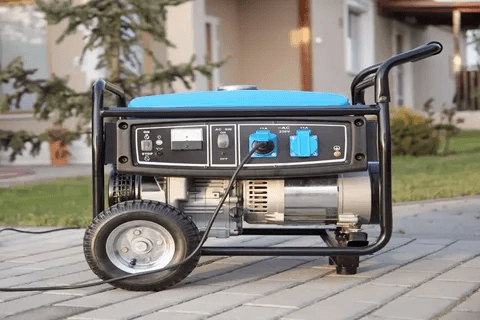
You should first know the differences in watts operating versus starting before you calculate the number of appliances you can run. Start-up Appliances with motors such as fridges and freezes can draw up to ten times their published wattage during start-up and this distinction can be crucial in selecting the correct size generator.
Running watts are the power that is required continuously to run an appliance at its normal powered state. Additional power needed to start motor-driven appliances is referred to as starting watts (or surge watts). An example of that is a refrigerator, which uses about 600 watts but when starting the same refrigerator engine and compressor it may consume up to 1800 watts.
Your calculation works like this: the amount of running wattage of all the appliances that you wish to have running at the same time (add them all together), and then one must find the highest starting watts of all of them together so that they can successfully run as a single unit on a single generator.
Essential Kitchen Appliances and Their Power Needs
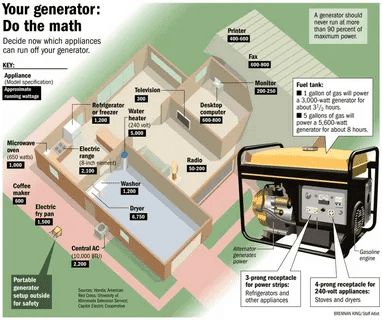
It is usually the power greedy appliances that are concentrated in the kitchen within your homestead. The knowledge of their wattage needs comes in handy and will guide you on the order of the devices to be powered in case of an outage.
Refrigerator and Freezer Requirements
Probably your refrigerator is expected to be the most essential equipment that you need to keep working in case there is any power outage. The running watts of the modern refrigerators are usually 600-800 watts whereas the starting ones are 1800-2400 watts. The upright freezers consume a little more at 500-700 running watts and chest freezers, 400-600 running watts and 1,200-1,800 starting watts.
Cooking Appliances Power Consumption
The size and wattage rating of your Microwave oven will make quite a difference in the amount of power they will use. Compact microwaves utilise 600-800 watts as compared to bigger versions which may utilize 1,000-1,500 watts. One of the most power-intensive devices is the electric range and oven, although the individual burners and ovens require 1200-3000 watts and 2000-5000 watts respectively.
The dishwashers consume 1,800-2,500 watts when in use together with their heating components and pumps. Coffee machines have a wattage of between 800-1,200 whereas the toasters require 800- 1,500 watts when in use.
HVAC System Generator Requirements
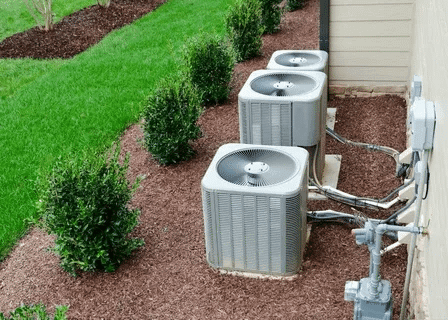
The heating, ventilation and air conditioning system in your home portrays to be the largest single consumption unit in most households. Small constructions with central air conditioning systems may have up to 3,000-5,000 watts of consumption and 7,000+ watts consumption in bigger systems. Heat pumps are practically the same in terms of requirements, 3,000-6,000 watts being consumed, dependent on size and efficiency.
Electrics furnaces are especially energy-intensive, and typically need 10,000 to 25,000 watts or more. Electric-blower gas furnaces consume much less electricity, in the range of 600-1,200 watts in a blower motor and controls.
Window air conditioning provides a more reasonable option, while using 500-1,500 watts, concerning the BTU rating and the efficiency of the units. The common capacity of the portable air conditioners is 1,000-3,000 watts.
Laundry Room Appliance Power Demands
Appliances used to do laundry are among the greatest consumers of power in your house. Clothes dryers that use electricity normally use about 3,000-5,000 watts, and this is hard to be powered by smaller generators. Gas dryers consume much less power and it only takes 400-600 watts to operate the motor and controls.
Washing machines are different in power consumption depending on the size and features. The standard top-loading laundry machines have a power of 400-800 watts, and high-efficiency front-loaded ones come with a power of 300-500 watts. Nevertheless, they, similar to the other appliances that have motors, would also need more starting watts.
Electric water heaters use 3000-4.500 watts and are an important sustained load. Gas water heater requires considerably less energy, namely 300-500 watts of electricity to operate.
Living Room and Entertainment Power Requirements
Several things can be found in entertainment devices and equipments and home office devices which are less than house entertainment and kitchen and laundry equipments but it can easily rise when more devices are utilized.
The most modern LED TVs are rather energy-efficient (30-200 watts, again, according to their size and technology). The older Plasma TVs could draw 200-400 watts, whereas the projection TVs can draw 150-800 watts.
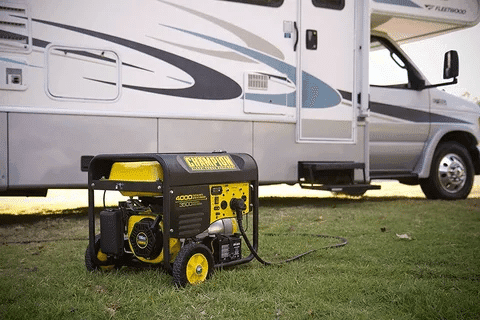
The power consumption of computer systems is very diverse. General computation of desktop computers is 200-500 watts and laptops are 50-100 watts. In high-use conditions, gaming computers consume 500-1000 watts or (greater).
Home theaters such as receivers, speakers and streaming devices might give an addition of 100-400 watts to your overall load. Routers and modems that access the internet are typically consuming 10-50 watts at a time.
Lighting and Basic Electrical Needs
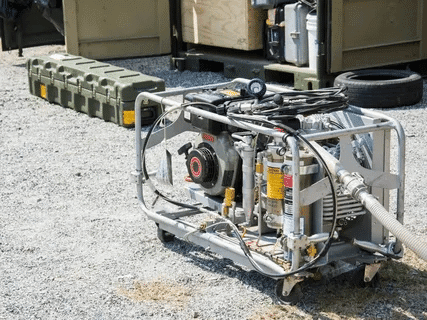
LED lights are also highly efficient with almost all of the LED bulbs using just 8-15 watts and producing the amount of light that regular 60-100 watt incandescent bulbs produce. Fluorescent lighting consumes between 15-40 watts as compared to conventional incandescent lamp that consumes 40-100 watts per lamp.
Ceiling fans utilise 50-100 watts on average, so they will still be a relatively powerful means of enhancing the level of comfort and not burdening your generator too much. The portable fans may have a power range of 20-75 watts.
Generator Sizing Guidelines for Different Home Types
In an average 2 bed house with only essentials items (a couple of lights, fridge, heating system) left on it can consume 5000 – 7000 Watts. Nonetheless, your unique requirements are based on the size of your home, efficiency of the appliances, and how you want to assimilate comfort.
A small 3,000-5,000 watt generator usually will cover most of the major appliances needed in a small apartment/condo; e.g., refrigerator, little lights, a microwave, and small electronics. With this installation, you will be able to stay relatively comfortable and food secure in case of outages.
The average medium-sized houses need 7,000-12,000 watts of power so that standard appliances can operate comfortably. It has this capacity that enables you to use your refrigerator, a freezer, a few lights, a microwave, a water heater, and heating or cooling systems.
The bigger houses or the power-hungry individuals would require 15,000 to 25,000 watts or more. Such ability to switch on several major appliances at the same time may enable you to use HVAC, water heater, and the majority of household electronics at the same time.
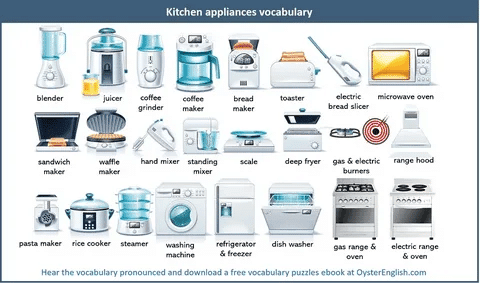
Calculating Your Generator Needs Step by Step
In order to know the correct size of generator to purchase to serve your home, you should follow the following procedural steps:
First, create a list of all the appliances you will need when there is power cut. Serve it on food preservation, simple light, heating or cooling, and communication apparatus. Next is researching in the form of running watts and starting watts of each device either on the manufacturers spec or in an appliance database.
Cut the total number of running watts of all the appliances that you want running simultaneously. This provides you your steady demand of power. Then, find the appliance that needs the most starting watts of what you intend to operate.
Your generator should not be run at a level that is greater than 80 per cent of its rating level continually. Put this into consideration by dividing your total wattage requirements by 0.8 so that you do not overpower your generator.
Think of the future requirements and possible other loads. You might tend to oversize generator by 20-30 percent more than what you find as what you need in order to meet sudden demands or future integration with new appliances.
Safety Considerations and Best Practices
Any good generator control regularly sustains power division by room and use. Begin with basic systems such as refrigeration, basic lighting and heating/cooling. Lastly, include convenience supplies according to the remaining fuel of your generator.
The refrigerator and freezer are the first priority in the kitchen and an addition is a microwave to prepare food. You must also not run so many high-wattage appliances at the same time unless you have a big generator.
To control the climate, you may choose window air conditioning or portable ones instead of central air conditioning system in case your generator capacity is low. Ceiling fan ensures effective comfort supplement using little power.
Bedrooms just concentrate on simple lighting and there may be a mini fan. When using electronics it is advisable to run one at a time only.
Room-by-Room Power Planning Strategy
Energy efficiency is very important during operation of the generator in order to maximize the run time and fuel usage. Consider LED bulbs to replace incandescent bulbs since LED bulbs consume 75 percent less energy but have the same capacity to produce bulbs.
When it is possible avoid electric cooking appliances and apply a microwave. Generally microwaves serve immediate re-heating and cooking of small amounts.
Put in place load management techniques to ensure that high wattage appliances do not run at the same time. As an example, it is not a good idea to use the dishwasher when the clothes dryer is in use.
Ensure that the heating and cooling loads are controlled through programmable thermostats. This can be achieved by changing temperatures up or down by a few degrees that could save a lot of power.
Energy-Efficient Alternatives and Load Management
Most people with homes also do not know their wattage requirements and therefore concentrate on running watts disregarding the starting watts. This control may cause overload of the generators and damage may be experienced once the motor driven appliances come to life.
The other mistake is the one that occurs, which is neglect to count the use of several appliances simultaneously. Individual appliances may be in the capacity of your generator but when you join several appliances this starts exceeding your available power.
Generators also become problematic in that they are oversized thus inefficient to operate with high levels of fuel consumption. Generators are usually the most efficient at around 50- 80 percent of their rated capacity.
Common Generator Sizing Mistakes to Avoid
Generators that are modern also have many features that can enhance compatibility of the appliances and operation. Inverter generators are clean and stabilized otherwise they would damage delicate electronics such as computers and TVs. They are also more fuel efficient and operate in a silent manner.
Automatic transfer switches allow smooth switching of power sources as well as prioritising basic circuits when the generator is in use. There are also systems with load management features that drop non-essential loads in case the generator is over-loaded automatically.
The remote monitoring systems give you the possibility of knowing the status of a generator, its fuel level and consumption capacity through the mobile phone. These characteristics make generator work efficiency and avoid overloading.
Advanced Generator Features and Considerations
High Level of Generator Function and Factors It is assumed that everyone knows the basics of using the generator and the preparation of the juice.
Generators that are modern also have many features that can enhance compatibility of the appliances and operation. Inverter generators are clean and stabilized otherwise they would damage delicate electronics such as computers and TVs. They are also more fuel efficient and operate in a silent manner.
Automatic transfer switches allow smooth switching of power sources as well as prioritising basic circuits when the generator is in use. There are also systems with load management features that drop non-essential loads in case the generator is over-loaded automatically.
The remote monitoring systems give you the possibility of knowing the status of a generator, its fuel level and consumption capacity through the mobile phone. These characteristics make generator work efficiency and avoid overloading.
Fuel Considerations and Runtime Planning
The amount of fuel present in your generator will determine the amount of time you get to operate your choice appliances. Most gasoline powered generators will run about 8-12 hours on a half load; whereas propane and natural gas can last a lot longer as long as fuel runs are not exhausted.
Compute the likely time that your appliances will run on the generator depending on the power capacity of your appliances and the effectiveness of your generator. Consider fuels when there is prolonged outage since gas stations can be out of fuel or perhaps operational.
How about the dual-fuel generator that can make use of gasoline and propane? Such flexibility will be able to maximize your operational ability when a specific type of fuel is out of supply.
Smart Load Management Technologies
The electrical loads during generator operation can be prioritized and run automatically under the modern home energy management systems. These systems have ability to shed excess load when the appetite of power is reaching its capacity in generators.
Smart thermostats have the ability to decrease heating and cooling schedules depending on available generator capacity and therefore to balance between comfort and power constraints. Others are even able to hold off the appliance power when the generator load is low.
When you need more appliances and the generator capacity is not enough, battery backup systems can back it up and ensure that you run the required number of appliances during a peak demand period.
Maintenance and Performance Optimization
A well-maintained generator will also operate at its best and when you require it the most. Clean filters of the air make it efficient and use less fuel. Routine check and replacing of oil, such machines work intensively compared to other engines.
Maintain freshness in fuel through the use of fuel stabilizers and rotation of stored gasoline after every few months. Old fuel may create a starting issue and hamper the efficiency of the generator.
To make certain that your generator is up to your intended appliances usage, do test run every month under realistic conditions. This exercise will allow spotting some problems before emergency situations can occur.
Conclusion
Operating appliances using your generator successfully requires knowledge regarding the power demand, calculation of the total loads, and application of smart management. Through careful consideration of the accompanied appliances that should power your household, the relationship between running watts and starting watts, and proper safety measures, you are able to stay inside your comfort and functional state during blackouts. It is worth remembering that the correct size generator takes the comfort of your needs in consideration to fuel efficiency and safety. Proper maintenance and testing will guarantee that when there is a power outage because of emergencies, your generator will faithfully operate your desired appliances to give you peace of mind and to ensure a quality lifestyle even when electricity decides to quit on you.

